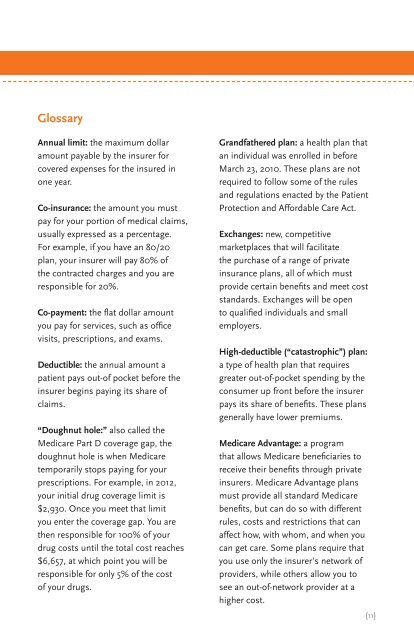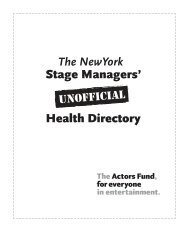How to Get Affordable Health Care in New York City - The Actors Fund
How to Get Affordable Health Care in New York City - The Actors Fund
How to Get Affordable Health Care in New York City - The Actors Fund
Create successful ePaper yourself
Turn your PDF publications into a flip-book with our unique Google optimized e-Paper software.
Glossary<br />
Annual limit: the maximum dollar<br />
amount payable by the <strong>in</strong>surer for<br />
covered expenses for the <strong>in</strong>sured <strong>in</strong><br />
one year.<br />
Co-<strong>in</strong>surance: the amount you must<br />
pay for your portion of medical claims,<br />
usually expressed as a percentage.<br />
For example, if you have an 80/20<br />
plan, your <strong>in</strong>surer will pay 80% of<br />
the contracted charges and you are<br />
responsible for 20%.<br />
Co-payment: the flat dollar amount<br />
you pay for services, such as office<br />
visits, prescriptions, and exams.<br />
Deductible: the annual amount a<br />
patient pays out-of pocket before the<br />
<strong>in</strong>surer beg<strong>in</strong>s pay<strong>in</strong>g its share of<br />
claims.<br />
“Doughnut hole:” also called the<br />
Medicare Part D coverage gap, the<br />
doughnut hole is when Medicare<br />
temporarily s<strong>to</strong>ps pay<strong>in</strong>g for your<br />
prescriptions. For example, <strong>in</strong> 2012,<br />
your <strong>in</strong>itial drug coverage limit is<br />
$2,930. Once you meet that limit<br />
you enter the coverage gap. You are<br />
then responsible for 100% of your<br />
drug costs until the <strong>to</strong>tal cost reaches<br />
$6,657, at which po<strong>in</strong>t you will be<br />
responsible for only 5% of the cost<br />
of your drugs.<br />
Grandfathered plan: a health plan that<br />
an <strong>in</strong>dividual was enrolled <strong>in</strong> before<br />
March 23, 2010. <strong>The</strong>se plans are not<br />
required <strong>to</strong> follow some of the rules<br />
and regulations enacted by the Patient<br />
Protection and <strong>Affordable</strong> <strong>Care</strong> Act.<br />
Exchanges: new, competitive<br />
marketplaces that will facilitate<br />
the purchase of a range of private<br />
<strong>in</strong>surance plans, all of which must<br />
provide certa<strong>in</strong> benefits and meet cost<br />
standards. Exchanges will be open<br />
<strong>to</strong> qualified <strong>in</strong>dividuals and small<br />
employers.<br />
High-deductible (“catastrophic”) plan:<br />
a type of health plan that requires<br />
greater out-of-pocket spend<strong>in</strong>g by the<br />
consumer up front before the <strong>in</strong>surer<br />
pays its share of benefits. <strong>The</strong>se plans<br />
generally have lower premiums.<br />
Medicare Advantage: a program<br />
that allows Medicare beneficiaries <strong>to</strong><br />
receive their benefits through private<br />
<strong>in</strong>surers. Medicare Advantage plans<br />
must provide all standard Medicare<br />
benefits, but can do so with different<br />
rules, costs and restrictions that can<br />
affect how, with whom, and when you<br />
can get care. Some plans require that<br />
you use only the <strong>in</strong>surer’s network of<br />
providers, while others allow you <strong>to</strong><br />
see an out-of-network provider at a<br />
higher cost.<br />
{11}
















